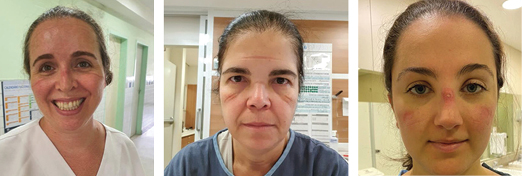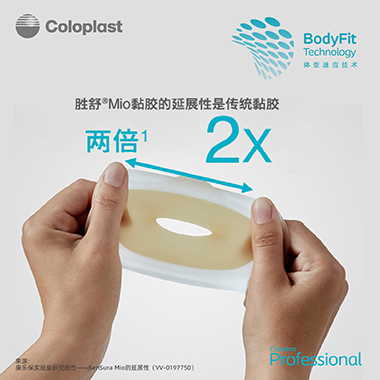Volume 40 Number 2
Medical device-related pressure injury in health care professionals in times of pandemic
Aline de Oliveira Ramalho, Paula de Souza Silva Freitas and Paula Cristina Nogueira
For referencing Ramalho A et al. Medical device-related pressure injury in health care professionals in times of pandemic. WCET® Journal 2020;40(2):7-8
DOI https://doi.org/10.33235/wcet.40.2.7-8
Facing the number of cases of coronavirus infection (COVID-19), the World Health Organisation (WHO) has declared that the disease, present in several countries and continents, is a pandemic of global alert and mobilisation1.
In Brazil, the pandemic arrived at the end of February 2020 and has been causing alarm due to the increase in the number of contaminated people related to the high capacity of transmission of the disease. In affected patients, the virus can cause from simple symptoms, which can be treated at home, to hospital admissions, assistance in intensive care units and can even lead to death2.
In the midst of this pandemic, the professionals who assist patients with suspected or confirmed COVID-19 infection constitute a population at high risk of contagion. In this way, preventive measures such as adequate hand hygiene and the use of personal protective equipment (PPE) have been reinforced.
Among PPEs, N95 type and similar respiratory protection masks should be used to perform procedures that generate aerosols, such as: intubation, noninvasive ventilation, aspiration and other care. In addition, the Society of Intensive Care Medicine recommends the constant use of this protection in intensive care environments that treat patients with confirmation and/or suspicion of COVID-193.
The WHO recognises the need for the use of a respiratory protection mask, but draws attention to the fact that it should not be used for more than four hours in a row, due to the discomfort resulting from its use. However, something has been drawing the attention of nurses, especially enterostomal therapists, which are the medical device-related pressure injuries4,5 caused by the use of N-95 mask. We have often seen in social media6 the dissemination of photos (Figures 1 and 2) of health professionals with skin lesions in the area of application of this PPE7.

Figure 1. Brazilian professionals with pressure injuries related to mask use. Images published with permission.

Figure 2. Images of Chinese healthcare workers with pressure injuries caused by PPE.6
Medical device-related pressure injury4,5 has been gaining prominence in national and international research, especially because we know that the devices used in health care are often indispensable, making it necessary to implement preventive measures or preventive recommendations to preserve the integrity of the skin in the area exposed to risk.
However, until now, the preventive recommendations have been directed to the patients under our care, although, in face of the current demands, it is fundamental to turn the attention also to the maintenance of the integrity of the professional’s skin, since the occurrence of the lesion can cause impacts on the care, quality of life and self-esteem, as well as presenting itself as an open door for infections.
With this in mind, some recommendations that are generally directed and carried out for the care of patients can also be applied to health professionals wearing breathing masks and other PPEs, in order to contribute to the maintenance of intact skin8,9:
- Clean the skin with liquid soap, preferably with a pH compatible with the skin (slightly acidified) and moisturise the skin with a cosmetic product (moisturising cream) without the presence of lipids;
- Apply a prophylactic coating as an interface between the skin and the mask attachment area (when the mask is used for a long time, especially in the zygomatic region and nasal bone), such as: thin polyurethane foam, silicone, transparent film or extra thin hydrocolloid plates;
- Schedule minutes of pressure relief, with the possibility of removing the mask every two hours;
- Inspect the skin frequently and watch for signs of pain, discomfort, hyperemia and injury;
- Avoid placing the mask and other PPEs on areas of skin lesions, eczema or hyperemia without proper prior topical treatment.
Health professionals, especially the nursing staff, are world-renowned for their heroism, their struggle and their self-sacrifice in caring for others. However, it is fundamental that self-care prevails at this time of pandemic, because it is necessary that professionals have their health preserved in order to collaborate with effective care for society.
Acknowledgments
The authors thank the collaboration of the Grupo de Pesquisa em Estomaterapia: estomas, feridas agudas e crônicas e incontinências urinária e anal, da Escola de Enfermagem da Universidade de São Paulo (GPET-EEUSP, Enterostomal Research Group: Stomas, acute and chronic wounds and urinary and anal incontinence, of the Nursing School of the University of São Paulo).
Funding
The authors received no funding for this study.
疫情期间专业医护人员的医疗器械相关压力性损伤
Aline de Oliveira Ramalho, Paula de Souza Silva Freitas and Paula Cristina Nogueira
DOI: https://doi.org/10.33235/wcet.40.2.7-8
考虑到新型冠状病毒感染(COVID-19)的病例数量,世界卫生组织(WHO)已宣布,这种出现在多个国家和大陆的疾病是一种全球警戒和动员的大流行1。
在巴西,疫情爆发于2020年2月底,由于疾病的高传播能力导致受感染患者数量增加,已引起警戒。在受感染的患者中,病毒可能导致可在家中治疗的简单症状,到住院、再到需要重症监护病房救治,甚至可能导致死亡2。
在此次疫情期间,为COVID-19感染疑似或确诊患者提供帮助的专业医护人员变成了接触传染的高危人群。为此,加强了预防措施,例如适当的手部卫生和使用个人防护装备(PPE)等。
在各种PPE中,应当使用N95型及类似的呼吸防护口罩进行可能产生气溶胶的操作,如:插管、无创通气、抽吸等护理。此外,重症监护医学会建议,在治疗COVID-19感染确诊和/或疑似患者的重症监护环境中,应一直使用这种防护装备3。
WHO认识到使用呼吸防护口罩的必要性,但也提请注意,由于其使用会带来不适,因此不应连续使用超过四个小时。然而,由于使用N-95口罩造成的医疗器械相关压力性损伤4,5,引起了护士特别是造口治疗师的重视。我们经常在社交媒体6上看到专业医护人员在使用此PPE的区域中发生皮损的照片分享(图1和图2)7。

图1.巴西专业医护人员因使用口罩而发生压力性损伤。图片经许可发布。

图2.中国医护人员因PPE而发生压力性损伤的图片。6
在国家和国际研究中,医疗器械相关压力性损伤4,5日益受到重视,尤其是因为我们知道医疗保健中使用的器械往往是不可或缺的,因此有必要采取预防措施或提出预防性建议,以保护暴露于危险之中的区域保持皮肤完整性。
然而到目前为止,预防性建议都是针对我们护理的患者,不过面对当前的需求,最根本的还是要把注意力同时投入到维护专业医护人员的皮肤完整性上,因为发生皮肤损伤可能影响护理、生活质量和自尊心,也会成为易受感染的途径。
考虑到这一点,通常针对护理患者实施的一些建议也可以应用于佩戴呼吸口罩和其他PPE的专业医护人员,以帮助维护其皮肤的完整8,9:
• 用液体皂清洁皮肤,最好具有与皮肤接近的pH值(略酸性),并用不含油脂的化妆品(保湿霜)滋润皮肤;
• 在皮肤和口罩附着区域(长时间使用口罩时,尤其是在颧区和鼻骨处)之间使用一层预防性涂层作为交界面,例如:薄聚氨酯泡沫、硅树脂、透明薄膜或超薄水胶体板;
• 安排几分钟的压力释放,如有可能,每两个小时取下一次口罩;
• 经常检查皮肤,注意是否有疼痛、不适、充血和受伤的征象;
• 避免在事先未进行适当局部治疗的情况下,将口罩和其他PPE佩戴在皮损、湿疹或充血的区域。
专业医护人员,尤其是护理人员,以其英勇表现、奋斗精神和关爱他人的自我奉献行为而闻名于世。但是,在疫情时期,自我照护至关重要,因为只有保护了专业医护人员的健康,才能通力协作,为社会提供有效护理。
致谢
作者感谢 Grupo de Pesquisa em Estomaterapia: estomas,feridas agudas e crônicas e incontinências urinária e anal,da Escola de Enfermagem da Universidade de São Paulo(GPET-EEUSP,圣保罗大学护理学院造口研究组:造口、急性和慢性伤口以及尿失禁和肛门失禁)的协作。
资助
作者未因该项研究收到任何资助。
Author(s)
Aline de Oliveira Ramalho*
Hospital Sírio Libanês, Serviço de Estomaterapia, São Paulo (SP), Brazil
Universidade de São Paulo, Escola de Enfermagem,
Departamento de Enfermagem Médico-Cirúrgica, São Paulo (SP), Brazil
Email alineo_ramalho@hotmail.com
Paula de Souza Silva Freitas
Universidade Federal do Espírito Santo,
Departamento de Enfermagem, Vitoria (ES), Brazil
Paula Cristina Nogueira
Universidade de São Paulo, Escola de Enfermagem,
Departamento de Enfermagem Médico-Cirúrgica, São Paulo (SP), Brazil
* Corresponding author
References
- World Health Organization (WHO). Rational use of personal protective equipment for coronavirus disease 2019 (COVID-19): Interim guidance. Geneva: WHO; 2020. [cited in 21 mar 2020]. Available at: https://apps.who.int/iris/bitstream/handle/10665/331215/WHO-2019-nCov-IPCPPE_use-2020.1-eng.pdf
- Monteiro N, Aquino V, Pacheco S, Scheneiders L. Saúde anuncia orientações para evitar a disseminação do coronavírus. Brasil: Ministério da Saúde; 2020. [cited in 21 mar 2020]. Available at: https://www.saude.gov.br/noticias/agencia-saude/46540-saude-anuncia-orientacoes-para-evitar-a-disseminacao-do-coronavirus
- Associação de Medicina Intensiva Brasileira (AMIB). Na UTI, a segurança da equipe é fundamental! São Paulo: AMIB; 2020. [cited in 21 mar 2020]. Available at: https://www.amib.org.br/fileadmin/user_upload/amib/2020/marco/07/COVID-19_seguranca_equipev14032020_18h16.pdf
- National Pressure Ulcer Advisory Panel (NPUAP). National Pressure Ulcer Advisory Panel (NPUAP) announces a change in terminology from pressure ulcer to pressure injury and updates the stages of pressure injury. Washington: Wound Source; 2016. [cited in 21 mar 2020]. Available at: https://www.woundsource.com/blog/national-pressure-ulcer-advisory-panel-npuap-announces-change-in-terminology-pressure-ulcer
- Caliri MHL, Santos VLCG, Mandelbaum MHS, Costa IG. Classificação das Lesões por pressão - Consenso NPUAP 2016 - Adaptada Culturalmente para o Brasil. São Paulo: SOBEST/SOBENDE; 2016. [cited in 21 mar 2020]. Available at: http://www.sobest.org.br/textod/35
- Mills J. Medics left with sore marks all over their skin from coronavirus face masks. Londres: Metro; 2020. [cited in 21 mar 2020]. Available at: https://metro.co.uk/2020/02/05/medics-left-sore-marks-skin-coronavirus-face-masks-12188952/
- Utaraitė N. Chinese nurses share pictures of how their faces look after countless hours fighting the coronavirus. Bored Panda. [cited in 26 mar 2020]. Available at: https://www.boredpanda.com/chinese-nurses-face-masks-corona-virus/?utm_source=google&utm_medium=organic&utm_campaign=organic
- Gefen A, Alves P, Ciprandi G, Coyer F, Milne CT, Ousey K, et al. Device-related pressure ulcers: SECURE prevention. J Wound Care. 2020;29(Sup2a):S1-52. https://doi.org/10.12968/jowc.2020.29.Sup2a.S1
- European Pressure Ulcer Advisory Panel; National Pressure Injury Advisory Panel; Pan Pacific Pressure Injury Alliance. Prevention and Treatment of Pressure Ulcers/Injuries: Clinical Practice Guideline – The International Guideline. EPUAP/NPIAP/PPPIA. 2019.


